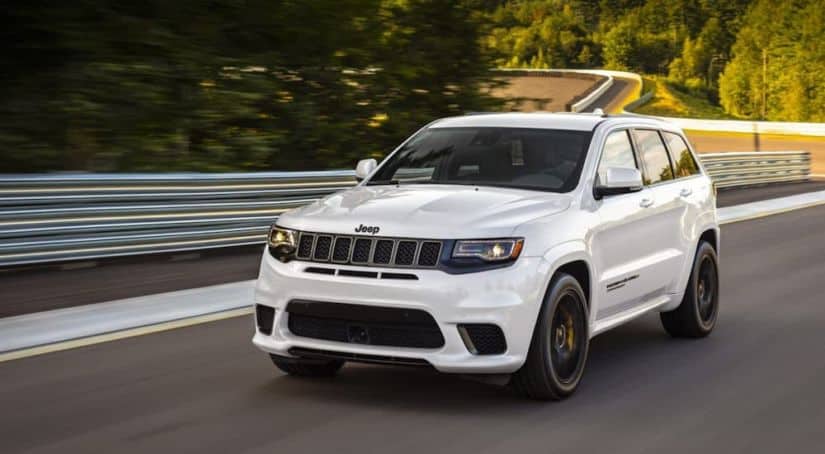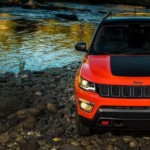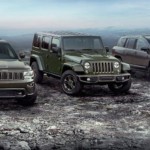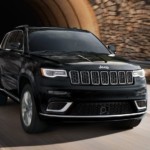It’s hard not to admire the Jeep brand of utility vehicles. Jeep’s long tradition of manufacturing durable, rugged rigs designed for adventurers, city dwellers, and everyone in-between is well-respected among automotive journalists, car lovers, and even normal everyday drivers. Over the years, Jeep models have changed and evolved, but the core vision is still present on every vehicle that leaves the assembly line. It’s the signature seven-slot grille and the round headlights that define the classic Jeep look and differentiate it from every other vehicle on the road today.
Jeep owners are part of a community. The brand has evoked a sense of adventure which is carried over into the ownership experience. Today there are hundreds of Jeep clubs around the country, and Jeep owners proudly give a wave––called the Jeep Wave––anytime they pass one another on the road. Owning a Jeep is about more than just owning a great utility vehicle; it’s a tribe of people that are deeply brand loyal.
What exactly drives this loyalty? While it’s clear that Jeep vehicles are fun and exciting to drive, the story goes a little deeper. This is a brand that breeds enthusiasts, not just owners, and its history and evolution tells us why. Let’s take a closer look at how it began, how it progressed, and where it is today. What is it about Jeep that gets America’s heart pumping?
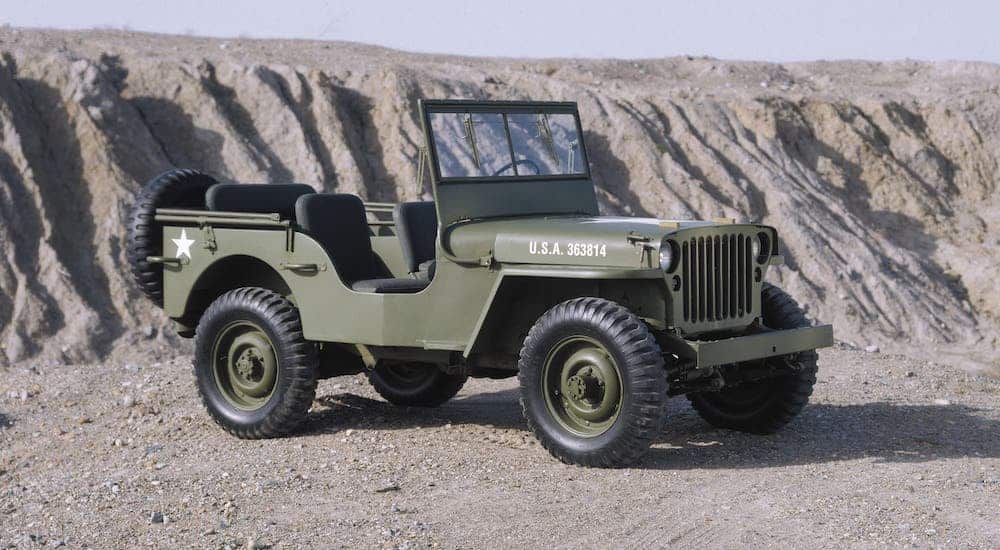
History of Jeep
The Jeep brand originated back in 1940, its roots dating back to World War II when the term ‘jeep’ referred to new Army recruits. The term soon came to describe the small 4×4 military vehicles used by the United States during and after the war. It’s thought that this early Jeep version inspired the Humvee and even the first Land Rover series of vehicles. No one knows for sure, but the name Jeep might have started with a mispronunciation of the initials G.P. What we do know for sure is the Jeep brand was born in the military.
The first consumer-focused Jeep, the CJ––short for Consumer Jeep––debuted in 1945 and was followed by the popular Wrangler, still in production today. The iconic Wrangler is still made with solid front and rear axles, a rarity for four-wheel drive vehicles. The solid-axle design provides a stable and simple foundation for lift kits, which is why so many Jeeps are lifted in order to accommodate larger tires and provide greater off-road capabilities. The current Wrangler is also offered in a four-door model, which has grown more popular every year since its release.
Jeep was originally owned by Willys-Overland, which later sold to Kaiser Motors. From there, American Motors Corporation––better known as AMC––purchased the Jeep brand in 1970. Under AMC’s ownership, Jeep realized its first 100,000 unit sales year. Then, in 1987, Chrysler stepped in and took over the Jeep brand. Currently, Jeep is owned by Fiat Chrysler Automobiles, an Italian-American conglomerate.
Jeep on the Big Screen
Jeep has had more than its share of the Hollywood spotlight. It’s been featured in a long list of movies and TV shows, sometimes in a leading role. Probably its most iconic appearance was in the 1993 blockbuster Jurassic Park. In a now-famous scene, the highly modified Jeep Wrangler Sahara takes on a T-Rex and wins. 1996’s disaster movie Twister featured a 1982 J-10 as its storm chasing vehicle of choice.
Let’s not forget the quintessential car nut movie series, Fast and Furious. In 2015, a heavily armored, souped-up Wrangler stole the show when it was dropped from a cargo plane in Furious 7, part of a promotional partnership between the popular franchise and Fiat Chrysler, where the automaker supplied close to 30 vehicles for the film.
Popular TV shows like Charlies Angels, The Dukes of Hazard, and the more recent AMC series, The Walking Dead, all feature Jeep vehicles prominently in their storylines. Even animated series get in on the fun, with characters on shows like King of the Hill and MTV’s Beavis & Butthead seen cruising around town in a Jeep.
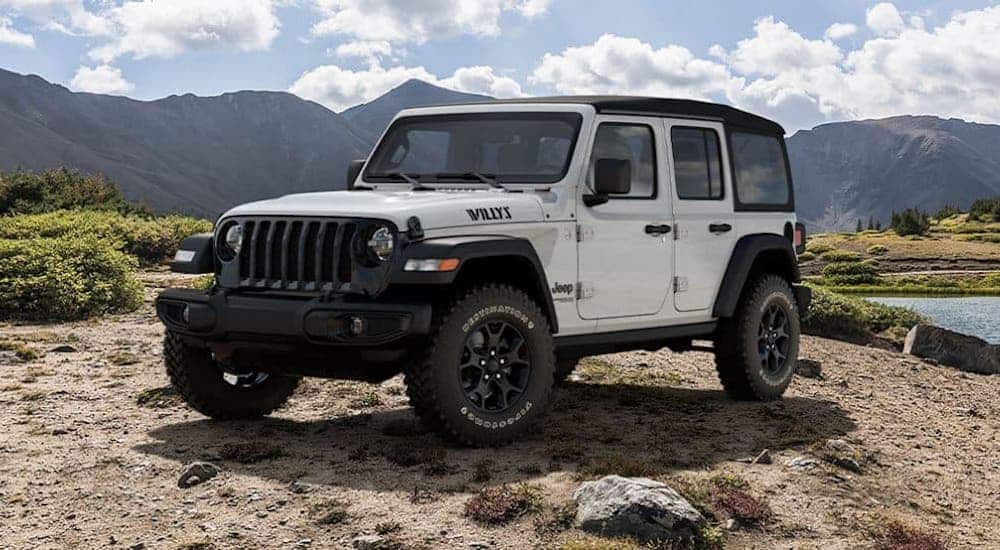
Today’s Jeep Models
Jeep continues to offer a wide assortment of rugged, versatile utility vehicles even today. The 2020 lineup of Jeeps includes the iconic core Wrangler, the Cherokee and Grand Cherokee, the smaller Compass and Renegade, and the all-new Gladiator truck style utility vehicle. Prices range from $22,280 for the entry-level Compass, up to $34,000 for the Grand Cherokee, with a fully loaded Grand Cherokee Trackhawk creeping over the $80,000 price point. Each Jeep model offers a wide range of standard equipment, along with several options and packages that allow you to customize your vehicle.
Jeep’s Limited Edition High Altitude line elevates luxury and options to a new level. The Grand Cherokee High Altitude features Nappa leather seats, a CommandView Dual-Pane Panoramic Sunroof, and 20-inch low-gloss granite crystal aluminum wheels. The granite crystal look appears in the badging, grille, taillights, and step pad, creating a matte look that enhances the Grand Cherokee’s already aggressive styling.
The Grand Cherokee Limited nudges Jeep into the luxury SUV segment. Starting at $40,200, the Limited is loaded with luxury and comfort features that rival any import. Power everything, including Uconnect, the app-based control center that lets you lock and unlock doors, remote start the vehicle, and access vehicle data in order to keep up with maintenance and receive notification of any system issues.
In a blast from the past, the 2020 Jeep Wrangler Willys harkens back to its 1948 roots and the original Willys Overland CJ-3A, which Jeep calls the ‘father of recreational vehicles.’ If a Wrangler can be extra-rugged, the Willys is it. Featuring high-performance shock absorbers and gritty 32-inch Firestone Mud-Terrain T/A Tires mounted on 17-inch black five-spoke wheels, the Wrangler Willys is ready for the most spirited off-road adventure.
There are so many words we can use to accurately describe a Jeep, including adventurous, rugged, and unique, but what comes to mind most of the time is iconic. This tried-and-true American brand is woven through the fabric of our society and is associated with our universal quest for adventure and exploration.
We want to experience the life of a Jeep owner, one that is rich with spontaneity and fun. We want to be part of the Jeep family because it’s a club, and that club is made up of people that wave as they pass one another, a nod to the secret society of Jeep owners. We want to traverse rocky mountains and pitch a tent under the stars. Jeep embodies adventure, and we know that by owning one, we’re tapping into a long, storied history of epic journeys and backroads exploring.
Buy A Jeep, Join a Family
The best part about owning a Jeep is that you don’t have to channel your inner Indiana Jones to enjoy it. Jeep vehicles translate into Main Street America, with vehicles that work for families, busy professionals, and city dwellers alike. The company has structured its lineup of utility vehicles to accommodate buyers at multiple entry points. Whether your interest in Jeep models is budget-related or you are one of the true adventure seekers, Jeep answers the call with a model that will work for you.
Next time you’re driving around town, notice the vehicles around you. Chances are you’ll see a lot of Jeeps. That’s no accident. Jeep has earned its spot as one of the most popular, preferred vehicle brands in the country. Pride of ownership abounds. Don’t believe us? Just ask a Jeep owner why they like their vehicle. You’d best be sitting down when you do because it’s going to take them quite a while to share all the reasons.
